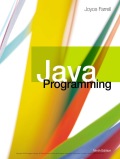
a.
Explanation of Solution
Program:
File name: “Die.java”
//Define a class named Die
public class Die
{
//Declare the private variables and initialize the value
private int value;
private static final int HIGHEST_DIE_VALUE = 6;
private static final int LOWEST_DIE_VALUE = 1;
//Define a Die method
public Die()
{
//Calculate the value
value = ((int)(Math.random() * 100) % HIGHEST_DIE_VALUE +
LOWEST_DIE_VALUE);
}
//Define a getValue method
public int getValue()
{
//Return the value
return value;
}
}
File name: “FiveDice2.java”
//Define a class named FiveDice2
public class FiveDice2
{
//Define a main method
public static void main(String[] args)
{
//Declare a variable and initialize the value
final int NUM = 5;
//Store the five dice rolled value for computer
Die[] comp = new Die[NUM];
//Store the five dice rolled value for player
Die[] player = new Die[NUM];
//Declare a variable
int x;
//For loop to be executed until x exceeds NUM
for(x = 0; x < NUM; ++x)
{
//Allocating memory for the array objects
comp[x] = new Die();
player[x] = new Die();
}
//Declare the variables
int compMatch, playerMatch;
//Get computer name
String computerName = "Computer";
//Get player name
String playerName = "You";
//Display the message
display(computerName, comp, NUM);
display(playerName, player, NUM);
//Calls the method to find same numbers for computer
compMatch = howManySame(comp, NUM);
//Calls the method to find same numbers for player
playerMatch = howManySame(player, NUM);
//If computer has one of a kind
if(compMatch == 1)
//Print the result
System.out.println("Computer has nothing");
//Else computer has a pair, three, four, or five of a //kind
else
//Print the result
System.out.println("Computer has " + compMatch + " of a kind");
//If player has one of a kind
if(playerMatch == 1)
//Print the result
System.out.println("You have nothing");
//Else player has a pair, three, four, or five of a kind
else
//Print the result
System.out.println("You have " + playerMatch + " of a kind");
//If any higher combination of computer beats a lower //one of player
if(compMatch > playerMatch)
//Print the result
System...
b.
Explanation of Solution
Program:
File name: “Die.java”
//Define a class named Die
public class Die
{
//Declare the private variables and initialize the value
private int value;
private static final int HIGHEST_DIE_VALUE = 6;
private static final int LOWEST_DIE_VALUE = 1;
//Define a Die method
public Die()
{
//Calculate the value
value = ((int)(Math.random() * 100) % HIGHEST_DIE_VALUE +
LOWEST_DIE_VALUE);
}
//Define a getValue method
public int getValue()
{
//Return the value
return value;
}
}
File name: “FiveDice3.java”
//Define a class named FiveDice3
public class FiveDice3
{
//Define a main method
public static void main(String[] args)
{
//Declare a variable and initialize the value
final int NUM = 5;
//Store the five dice rolled value for computer
Die[] comp = new Die[NUM];
//Store the five dice rolled value for player
Die[] player = new Die[NUM];
//Declare a variable
int x;
//For loop to be executed until x exceeds NUM
for(x = 0; x < NUM; ++x)
{
//Allocating memory for the array objects
comp[x] = new Die();
player[x] = new Die();
}
//Declare the variables
int compMatch, playerMatch;
int compHigh, playerHigh;
//Get computer name
String computerName = "Computer";
//Get player name
String playerName = "You";
//Display the message
display(computerName, comp, NUM);
display(playerName, player, NUM);
//Calls the method to find same numbers for computer
compMatch = howManySame(comp, NUM);
//Calls the method to find same numbers for player
playerMatch = howManySame(player, NUM);
//Compute the value
compHigh = compMatch / 10;
playerHigh = playerMatch / 10;
compMatch = compMatch % 10;
playerMatch = playerMatch % 10;
//If computer has one of a kind
if(compMatch == 1)
//Print the result
System.out.println("Computer has nothing");
//Else computer has a pair, three, four, or five of a //kind
else
//Print the result
System.out.println("Computer has " + compMatch + " of a kind");
//If player has one of a kind
if(playerMatch == 1)
//Print the result
System.out.println("You have nothing");
//Else player has a pair, three, four, or five of a kind
else
//Print the result
System.out.println("You have " + playerMatch + " of a kind");
//If any higher combination of computer beats a lower one of player
if(compMatch > playerMatch)
//Print the result
System.out.println("Computer wins");
//Else
else
//If any higher combination of player beats
//a lower one of computer
if(compMatch < playerMatch)
//Print the result
System.out.println("You win");
//Else
else
{
//If values of computer are greater than player's value
if(compHigh > playerHigh)
//Print the result
System...
Trending nowThis is a popular solution!

- Considering the TM example of binary sum ( see attached)do the step-by-step of execution for the binary numbers 1101 and 11. Feel free to use the Formal Language Editor Tool to execute it; Write it down the current state of the tape (including the head position) and indicate the current state of the TM at each step.arrow_forwardI need help on inculding additonal code where I can can do the opposite code of MatLab, where the function of t that I enter becomes the result of F(t), in other words, turning the time-domain f(t) into the frequency-domain function F(s):arrow_forwardI need help with the TM computation step-by-step execution for the binary numbers 1101 and 11. Formal Language Editor Tool can be used to execute it; Write it down the current state of the tape (including the head position) and indicate the current state of the TM at each step;arrow_forward
 EBK JAVA PROGRAMMINGComputer ScienceISBN:9781305480537Author:FARRELLPublisher:CENGAGE LEARNING - CONSIGNMENT
EBK JAVA PROGRAMMINGComputer ScienceISBN:9781305480537Author:FARRELLPublisher:CENGAGE LEARNING - CONSIGNMENT EBK JAVA PROGRAMMINGComputer ScienceISBN:9781337671385Author:FARRELLPublisher:CENGAGE LEARNING - CONSIGNMENT
EBK JAVA PROGRAMMINGComputer ScienceISBN:9781337671385Author:FARRELLPublisher:CENGAGE LEARNING - CONSIGNMENT Microsoft Visual C#Computer ScienceISBN:9781337102100Author:Joyce, Farrell.Publisher:Cengage Learning,
Microsoft Visual C#Computer ScienceISBN:9781337102100Author:Joyce, Farrell.Publisher:Cengage Learning,- Programming Logic & Design ComprehensiveComputer ScienceISBN:9781337669405Author:FARRELLPublisher:Cengage
 Programming with Microsoft Visual Basic 2017Computer ScienceISBN:9781337102124Author:Diane ZakPublisher:Cengage Learning
Programming with Microsoft Visual Basic 2017Computer ScienceISBN:9781337102124Author:Diane ZakPublisher:Cengage Learning C++ for Engineers and ScientistsComputer ScienceISBN:9781133187844Author:Bronson, Gary J.Publisher:Course Technology Ptr
C++ for Engineers and ScientistsComputer ScienceISBN:9781133187844Author:Bronson, Gary J.Publisher:Course Technology Ptr





